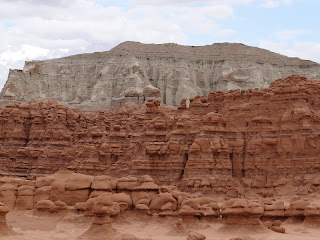A correction from last blog: David Roberts’ book is entitled In Search of the Old Ones.
Yesterday we established our campsite at the state park in the town of Green River, at the base of the Book Cliffs (and Tavaputs Plateau).
It is a nice, quiet campground with great hot showers and very clean. Not only is the campground the launching point for those who want to raft down the Green River (peaceful for the next 50 miles until it merges with the Colorado), the campground is also adjacent to the park’s golf course.
We are enjoying a “country club” setting in our 2-person townhouse.
Today, we went on three excursions into the San Rafael Swell area. First was Black Dragon canyon, which has some important pictographs from the Barrier Canyon culture. We located other Barrier Canyon pictographs at the Temple Mountain wash further south. And we took some time out to have some fun hiking in Goblin State Park.
We have been writing about “rock art” for a few weeks now--petroglyphs and pictographs. Goblin Valley State Park has a third kind of rock art: rocks that stir the imagination. Like the ancients, we still “read” rocks and see images and omens in them. We personify nature as much as the ancients did.
Goblin Valley State Park is a reminder that topography can have iconographic influence on our perceptions. Watching visitors hike through the park with delight made it clear to us that adults, as much as children, personify what they see.
As the name suggests, Goblin Valley could have been created by a cartoonist, graphic artist, or science fiction writer. The place sort of looks like it belongs to another planet and has in fact been used as a setting in a few Hollywood movies for that purpose.
I suspect a few cartoonists and puppeteers have been influenced by the goblins here.
To Tolkien fans, the rock “goblins” here look like a happy bunch of hobbits, waiting for their Bilbo Baggins.
Well, some do seem grumpy.
Perhaps they are not pleased by the tourists. Others, though, seem as contented as Barney on TV.
As we hiked among them, several “goblins” seemed to be keeping a close eye on us.
One E.T. look alike appeared especially lost, looking for home.
He seemed particularly intent on following Janet,
who took refuge between two body guards.
It turned out that he just wanted help with his college essay, to the annoyance of the folks back in goblin/hobbit valley.
These formations gave everyone a boot,
although some, like the giant toad,
could get scary. Fortunately for us the chess pieces promised to protect the kings.
It is a lesson in perception—the rocks becoming a kind of lithic Rorschach test of human obsessions.
Who knows, places of such lithic imagination (litho-graphics?), like this location, may even have inspired the barrier canyon rock artists. Certainly, from a distance, patterns of “desert varnish” on rocks initially resemble Barrier Canyon anthromorphs.
Moreover, the prominence of serpentine features in the landscape may have influenced beliefs about the powers of the horned serpent.
Several times, Janet and I have had to stop to make sure we were not passing by some rock art.
Goblin Valley State Park certainly gives a valuable lesson in geological stratification and erosion processes. There were lots of kids here, as well as young adults, learning to see rocks in new ways. We counted about two dozen Cruise-Americas (RVs used extensively by European tourists) and lots of cars. Unfortunately, the whole time we were here we heard not a single word of English from anyone else. That made us both proud and sad at the same time. Europeans are fascinated with our landscape. But why should European children know the topography of the American West better than our own children? The American families we meet are all headed to the National Parks for a quick drive through—like McDonald’s.
(Don’t misunderstand my point. Janet and I love visiting the national parks. It is just that the mission of the park service is to protect the parks from the tourists, as David Roberts points out from talking with national park rangers. That is probably a good idea. But it tells the story of our land and people as simplistically as possible. We also eat at McDonald’s a lot, but I would not want to rely on it for long-term nutrition.)

















No comments:
Post a Comment